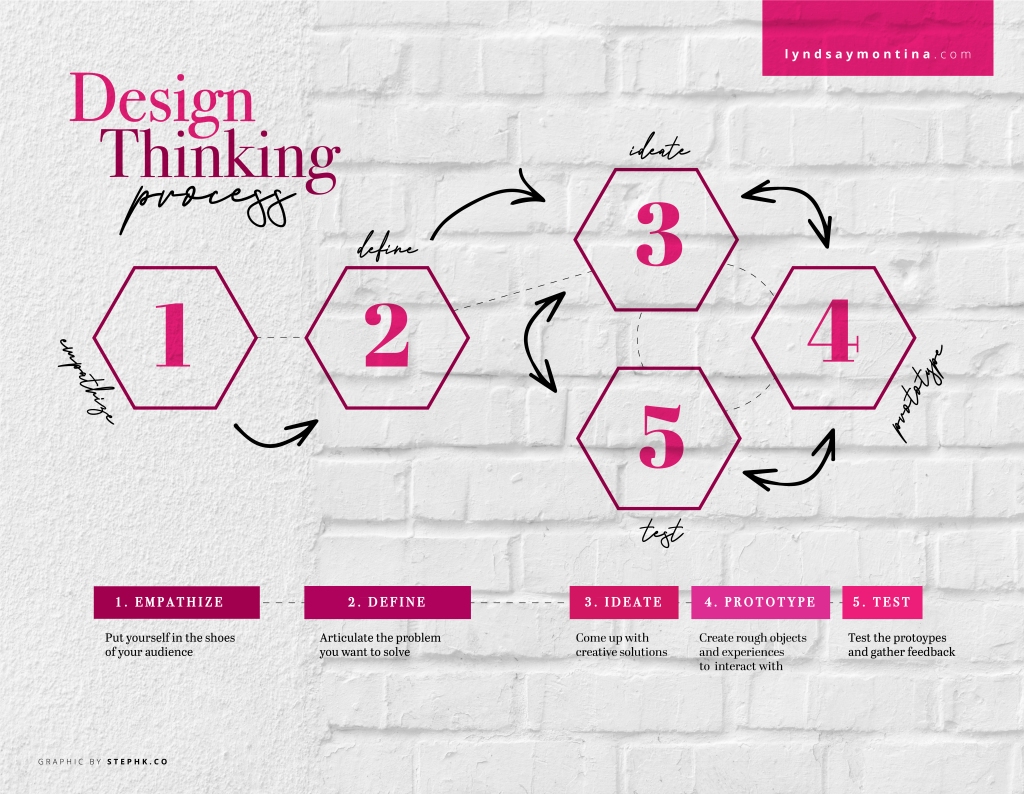“Success today requires the agility and drive to constantly rethink, reinvigorate, react and reinvent”
Bill Gates
Two of the skills I look for when I’m hiring are agility and innovation. We live in a constantly changing world where we need to be agile enough to pivot quickly. This requires us to be able to let go of a plan, regroup, reimagine and course-correct while not taking the change or failure personally. If you’re not used to working this way it can be uncomfortable, but luckily these skills can be strengthened. One way to embrace innovation and flex those muscles is to become a design thinker.
The design thinking process provides a framework to ensure the solutions you are creating are relevant to your audience. I am an avid supporter and user of design thinking within my personal and professional life. I love bringing groups of people together and coming away with out-of-the-box ideas that meet the needs of the audience in mind.
So, what is design thinking?
Design thinking is an iterative process that focuses on creating solutions that work for the end-user. Solutions can take the shape of a product, experience, service, program or anything between. The term “design thinking” might sound like you need to be an engineer or graphic designer to use the process, but you don’t! These principles can be used in any type of work.

Let’s dive into the five phases of design thinking:
- Empathize. Put yourself in the shoes of your audience and get to know their needs through observation and immersive experiences. Develop a persona and become this person when you move onto the next steps.
- Define. Articulate the problem you want to solve based on what you learned from your research gathered in the empathize phase. Developing a strong problem statement is the key to creating meaningful solutions.
- Ideate. This is one of my favourite stages! In this stage, you create innovative ideas through divergent thinking.
- Prototype. Choose a few of your ideas and create very rough objects, experiences or anything the audience can interact with. By rough I mean, use post-it notes, tin foil, pipe cleaners and other inexpensive materials to create your prototype. It doesn’t need to be beautiful.
- Test. Test your prototypes by getting your audience to engage with them and provide feedback*
*Be sure to take the feedback you receive in the test phase and implement it. This might mean you need to go through the ideate, prototype and test phases again.
Why should I become a design thinker?
I use the principles of design thinking at work and find I’m more satisfied with the solutions when I do. The process is fun and the outcomes are innovative. Becoming a design thinker has many benefits including:
Creating Competitive Advantages. Finding unique solutions to your problems gives you and your organization competitive advantages. You’re designing innovative solutions to meet people where they’re at; not where you want them to be.
Developing Resilience. John C. Maxwell said, “Fail early, fail often, but always fail forward.” We’ve been conditioned to believe that failures are negative and we should avoid them at all costs but we need to let go of this idea. Put your ideas out there. They might fail but you’ll become more resilient over time. When you do have your first epic fail, think of me cheering for you from the sidelines. Even better, tell me about it! I want to hear about it.
Adding Tools to your Professional Toolbox. There are many different tools and methods that can help with collaboration. These tools are valuable any time you’re holding a workshop, retreat or group meeting. Your colleagues will be impressed with your skills when you introduce a simple method that allows people to think differently.
Becoming a Culture Changer. You can influence the future of your unit, department and your organization. By adopting an innovative mindset and getting others on board, you can change the way work gets done.
Stay tuned for more blog posts about how to put design thinking to work.
Be Brave,
Lyndsay
